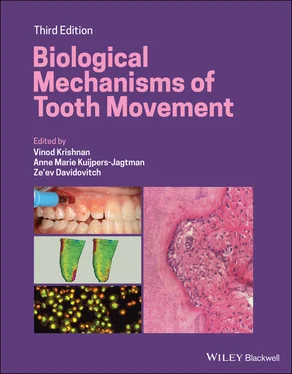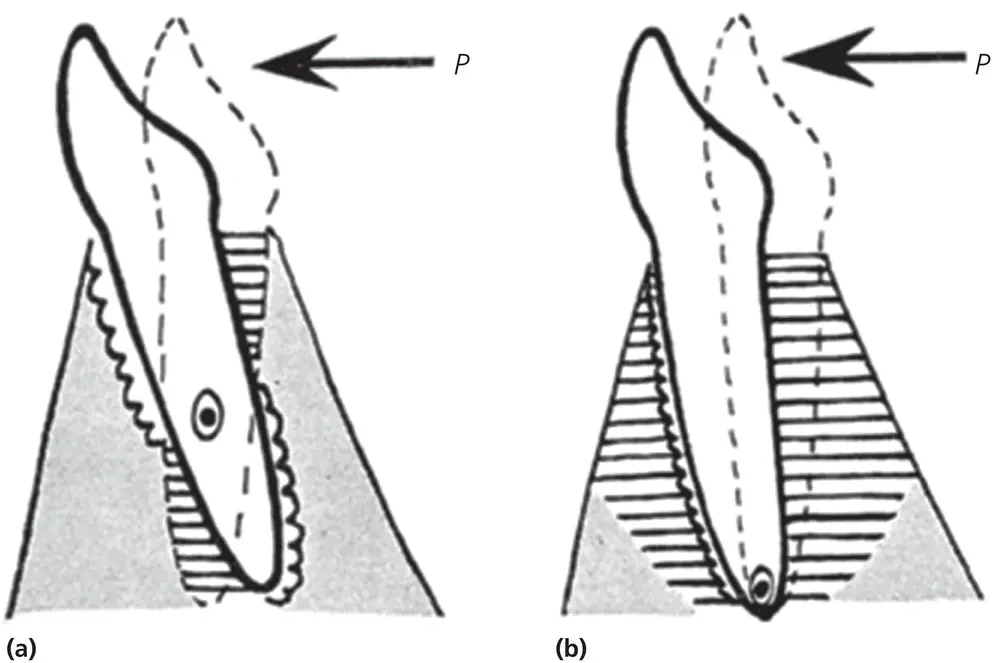
Figure 2.11 Comparative diagram of the theories put forward by Sandstedt (1904) and Oppenheim (1911) as drawn by Schwarz (1932). In (a), which depicts the theory of pressure (Sandstedt), the tooth moved by the force, P, tilts around an axis, O, lying a little apically from the center of the root. By this means two regions of pressure and pull arise, lying diametrically opposite. In the regions of pressure in the PDL, the old alveolar bone is resorbed (jagged line) and in the regions of pull, new bone is added (horizontal shading). Gray shading, alveolar bone without transformation. (b) This depicts the theory of transformation (Oppenheim, 1911, 1944). There is only one side of pressure and one side of pull. On both sides the alveolar bone opens into a transitional spongy bone, whose elements are arranged vertically to the surface of the tooth (horizontal shading). On the side of pressure, this newly formed transitional bone is resorbed (jagged line). On the side of pull, new bone is added. Gray shading indicates the old untransformed alveolar bone at a greater distance from the moved tooth,
(Source: Schwarz, 1932. Reproduced with permission of Elsevier.)
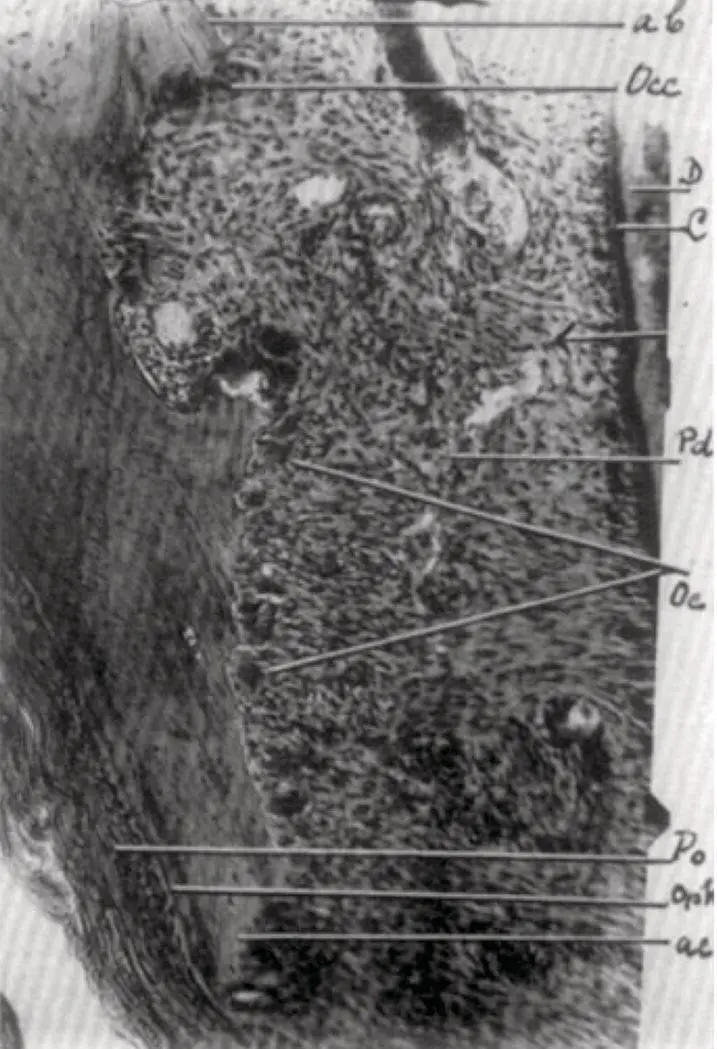
Figure 2.12 Higher magnification image from Oppenheim’s article (1944) showing labial alveolar crest. The aplastic zone facing the periodontium has for the greatest part disappeared, as has the crest itself. Where some aplastic bone is still present (ab), the secondary osteoclasts (Occ) are still at work removing it. No osteoclastic activity whatsoever is found at the periosteal smooth bone surface. The still remaining but decreased pressure caused the appearance of primary osteoclasts (Oc) and will be present for 2 days after force discontinuation. D, dentine; C, cementum; Pd, periodontal membrane; Po, formation of smooth periosteal bone surface; Opk, scarce osteophyte. ac, acellular cementum.
(Source: Oppenheim, 1944. Reproduced with permission of Elsevier.)
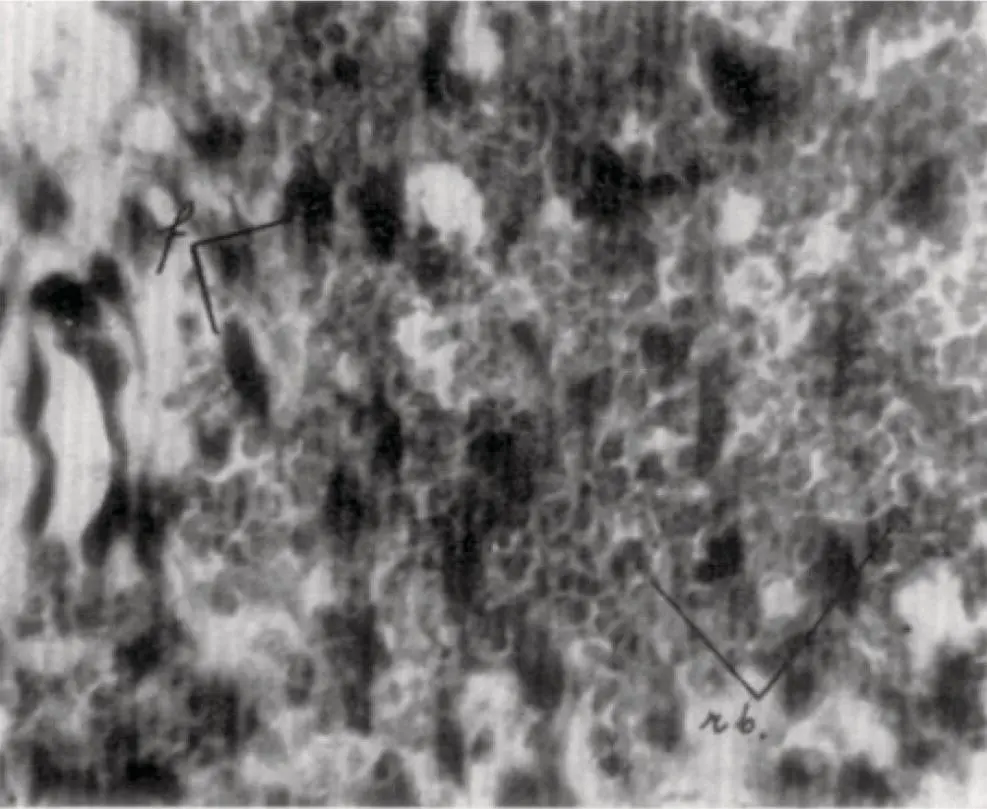
Figure 2.13 Higher magnification image of hemorrhage as portrayed in Oppenheim (1944).
(Source: Oppenheim, 1944. Reproduced with permission of Elsevier.)
In short, all three major researchers (Sandstedt, 1904, 1905; Oppenheim, 1911, 1944; Schwarz, 1932) exploring tissue reactions during OTM, agreed that there is a creation of pressure and tension sites in the PDL during OTM. Furthermore, it appears that cell replication is decreased in pressure sites owing to a decrease in vascular supply, whereas it is increased in tension sites due to PDL fiber stretching.
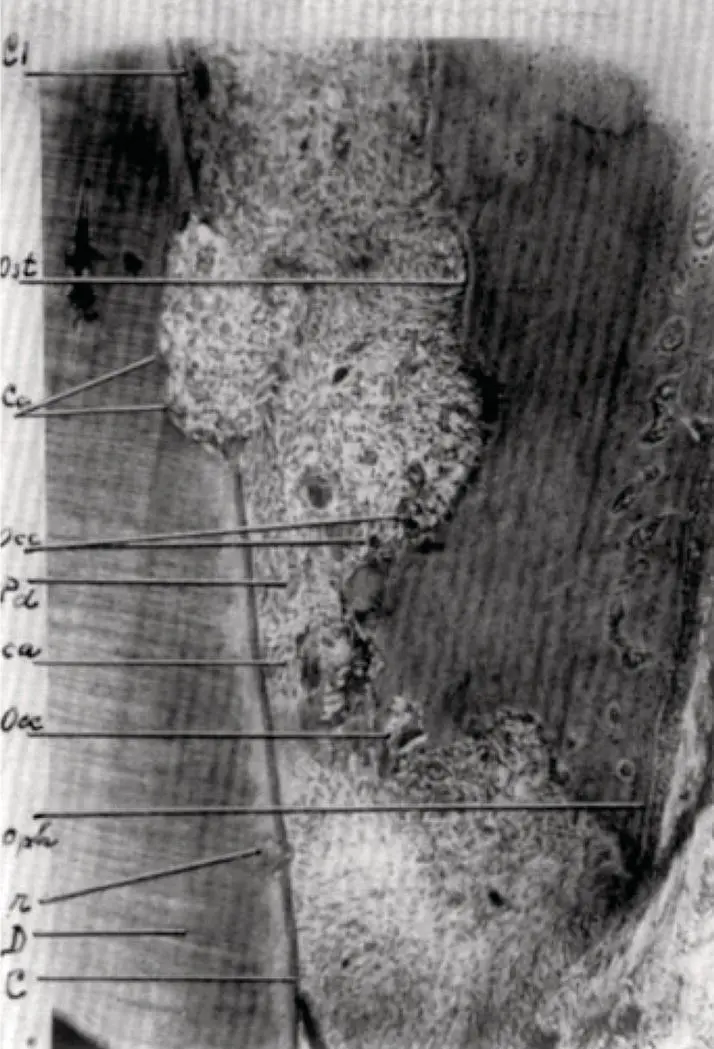
Figure 2.14 Hyalinization reaction as portrayed in Oppenheim (1944). The osteocytes are mostly normal; the osteophytic bone formation (Oph) is quite poor; no sign of any periosteal osteoclastic activity was found. The cementum within the compression area is aplastic, and again displays its signs of vitality (cementoblasts, cementoid seam) above the compression area (C). Within this area, we see a cementum resorption with cementoclasts (Cc) still present 4 days after force discontinuation. A proof that the lowering of the crest has really taken place is found in the presence of another small cementum resorption (r) in a region opposite which bone is no longer present. The larger resorption, though not deep, is already quite extended buccolingually. Above the crest we find the effect of the relapse movement of 4 days, the formation of an osteoid seam (Ost). C, Aplastic cementum; D, dentine; Pd, periodontal membrane; ca, crushed periodontal tissue with hyaline degeneration and debris; Occ, secondary osteoclasts: Oph, osteophytic apposition; r, small cementum resorption: cc, greater cementum resorption with cementoclasts still present; Ost, osteoid.
(Source: Oppenheim, 1944. Reproduced with permission of Elsevier.)
Reitan (1957, 1960), in his classic papers on histological changes during OTM, reported that hyalinization refers to cell‐free areas within the PDL, in which the normal tissue architecture and staining characteristics of collagen in the processed histological material have been lost ( Figures 2.15and 2.16). He observed that:
hyalinization occurred within the PDL following the application of even minimal force, meant to bring about a tipping movement;
a greater degree of hyalinization occurred following application of force, if a tooth had a short root;
during tooth translation, very little hyalinization was observed.
Reitan (1960) concluded that the tissue changes observed were those of degeneration related to force per unit area, and that attempts should be made to minimize these changes.

Figure 2.15 Cell free areas as shown by Reitan (1960). The figure shows pressure in the PDL during tooth movement, where cells gradually disappear in a circumscribed area. A, Root surface: B, compressed cell free fibers; C, border line between bone and hyalinized tissue: D, undermining bone resorption; E, small marrow space in dense, compact lamina dura.
(Source: Reitan, 1960. Reproduced with permission of Elsevier.)
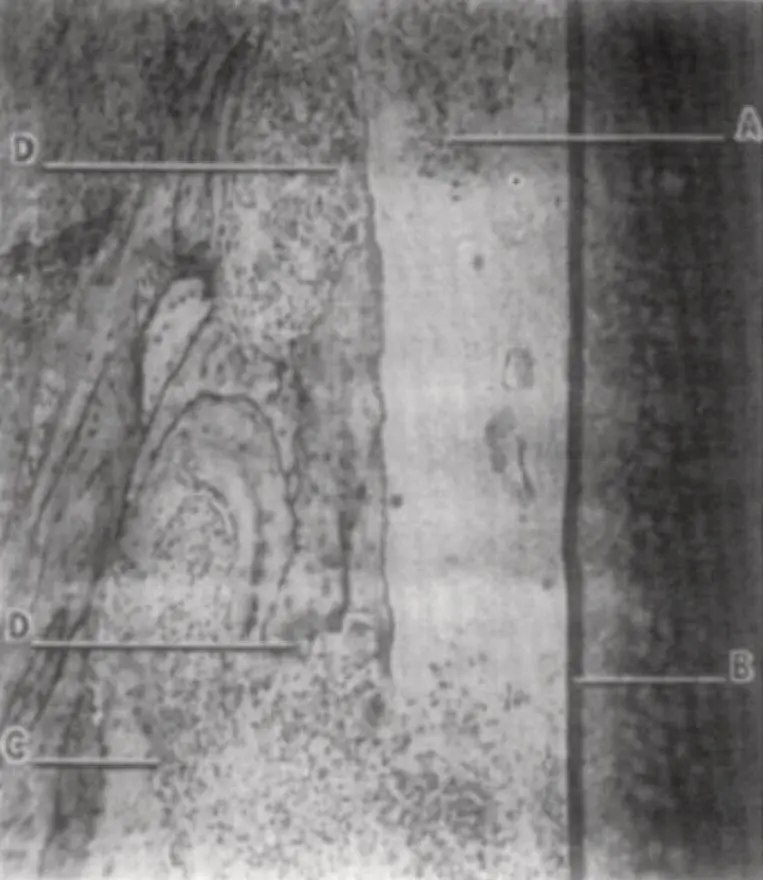
Figure 2.16 (A) Formation of cells and capillaries in hyalinized tissue after the force was released as shown by Reitan (1960). B, Root surface; C, direct resorption; D, undermining resorption.
(Source: Reitan, 1960. Reproduced with permission of Elsevier.)
The fluid dynamic hypothesis
Bien (1966), through his research on the effect of intrusive forces on mandibular incisors, recorded an oscillation of the force inside the dental socket, and named it the hydraulic damping effect. He identified three distinct but interactive fluid systems present in paradental tissues: the vascular system, interstitial fluids, and cellular fluids. All three are presumably involved in damping oscillations of the tooth. He used Reynold’s numbers to measure tooth oscillation and concluded that the low Reynold’s number observed for the tooth subjected to oscillations is due to predominance of viscous forces acting within the system. He observed an escape of extracellular fluids from the PDL to the marrow spaces through the minute perforations in the alveolar wall ( Figure 2.17). This phenomenon, occurring in the first stage of OTM, when PDL fibers are slack, depends mainly on size and number of alveolar bone perforations. The slack fibers become tightened once the extracellular fluids are exhausted. Owing to the presence of interstitial fluid or ground substance throughout the PDL, and the fact that the PDL is extremely thin, when compared with the sizes of the dental root and alveolus, he related the behavior of the PDL to that of the “squeeze film effect” proposed by Hays (1961). The presence of this film enables the tooth to withstand the heavy forces applied as part of orthodontic treatment or masticatory efforts. Masticatory forces, which are momentary in nature, will displace the fluid in the PDL space to its boundaries of the squeeze film (towards the apex and cervical areas of the dental root). Once the force is released, replenishment of fluid occurs through recirculation of interstitial fluid and diffusion through capillary walls, restoring the equilibrium. Likewise, a similar chain of events may occur following the application of low, sustained orthodontic forces.
Читать дальше
